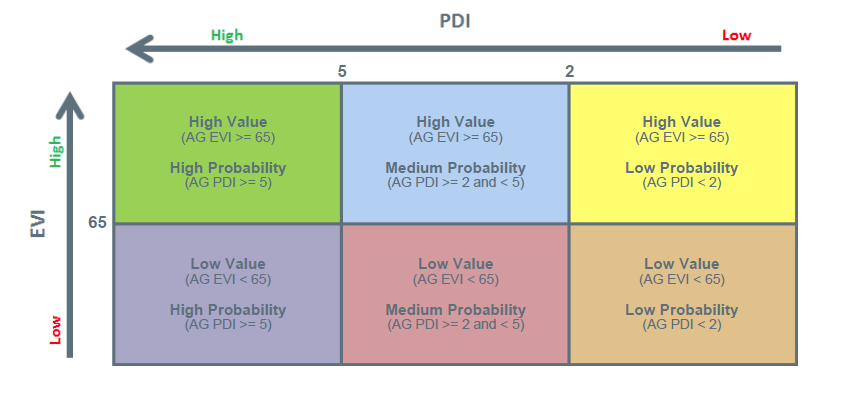The Six Square Segmentation Grid is a tool that groups all of an institution’s constituents into six segments based their Annual Giving Probability to Donate Index (AG PDI) and Annual Giving Expected Value Index (AG EVI) scores. Our research shows that forming a fundraising strategy around the Six Square Segmentation model, which entails marketing to constituents differently based on which squares they fall into, yields a higher return on investment and allows fundraisers to be more efficient and intentional with their efforts.
Segmentation Strategy
Green Square: The green square contains your constituents who are most likely to donate to annual giving and also most likely to donate at high values. We recommend investing heavily in high-touch direct marketing for these green square constituents, with multiple contacts in both personal phone calls and high-quality mailings, because this is where you will see the highest return on your investment. Most of your LYBUNTS and SYBUNTS will be in the green and purple squares. Expect higher levels of retention and renewal here.
Purple Square: The purple square includes constituents who have a high probability to donate but lower expected gift values. These are great constituents to solicit to improve your institution’s participation rate because they have a high probability to donate, but keep in mind that their gifts will come in at lower values. Here, we recommend investing strategically with lower cost mailings and limited phone attempts. Most of your LYBUNTS and SYBUNTS will be in the green and purple squares. Expect higher levels of retention and renewal here.
Blue Square: These constituents have high expected gift values and a medium, lower than average, probability to donate. You will need to work harder to secure gifts from these constituents, but when they give, their gifts will be of higher value. We recommend investing strategically in the blue square to secure these high value gifts. While there are likely some never-donors in the green and purple squares as well, you will have your highest percentage of strategic acquisition in the blue square.
Red, Yellow and Orange Squares: Constituents from all three of these squares have low expected value and lower than average probability to donate. These three groups will yield the lowest return on your investment. It isn’t impossible to secure donors from these squares, but you will end up spending more in order to secure gifts of lower value. We recommend limiting investment of resources in these constituents.
Parents and Recent Graduates: Due to the unique nature of these constituents, we recommend developing a separate strategy outside of the Six Square Segmentation for parents and recent graduates.
